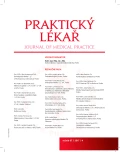Relationship between patients’ falls and selected risk factors
Authors:
I. Brabcová; H. Hajduchová; V. Tóthová; S. Bártlová
Authors‘ workplace:
Ředitelka: doc. PhDr. Sylva Bártlová, Ph. D.
; Ústav ošetřovatelství, porodní asistence a neodkladné péče
; Děkanka: prof. PhDr. Valérie Tóthová, Ph. D.
; Zdravotně sociální fakulta
; Rektor: doc. Tomáš Machula, Ph. D., Th. D.
; Jihočeská univerzita v Českých Budějovicích
Published in:
Prakt. Lék. 2017; 97(4): 163-167
Category:
Of different specialties
Overview
The aim of research was to verify connection between chosen risk factors for fall incidents of hospitalised patients and also circumstances of these incidents.
Methodology:
Research was conducted using quantitative method using retrospective analysis of fall incidents of hospitalised patients in four South Bohemian hospitals (Nemocnice České Budějovice, Nemocnice Tábor, Nemocnice Jindřichův Hradec and Nemocnice Písek). Research subjects were patients who had an incident of falling during 2014 and 2015 that was later reported. 1101 cases of falling incidents were analysed.
Results:
In 54% of falling incident reports for hospitalised patients earlier falling incident was reported in the patient case history. With patient age falling incidents appeared increasingly with statistical significance, the risk of falling increased, as did the severity of injuries caused by the fall. The retrospective analysis showed that patients with risk of falling in their case file were disoriented or confused, nurses significantly more often raised the sidebars of their beds. In 20% of the incidents the unraised bar was stated as the cause of the falling incident, On the other hand, in 36.5% of falling incident reports the reason of the fall were the bars raised along the whole length of the bed.
Conclusions:
When planning preventive interventions leading to decrease of the risk of falling incidents nursing personnel should consider the effectiveness of raising the bars on both sides of the bed along its whole length. A suitable alternative seems instead lowering the height of the bed, raising only bar on one bedside, or only the upper one. Another possibility is the so-called intelligent beds equipped by warning sensors for movement
Keywords:
health status – cardiovascular risk, Czech population, EHES 2014
Sources
1. Bowers B, Lloyd J, Lee W, et al. Biomechanical evaluation of injury severity associated with patient falls from bed. Rehabil Nurs 2008; 33(6): 253–259.
2. Brabcová I, Bártlová S. a kol. Management v ošetřovatelské praxi. Praha: NLN 2015.
3. Brown C J, Norris M. Falls. Physicians’ Information and Education Resource (PIER.) American College of Physicians 2004 [online]. Dostupné z: http://pier.acponline.org/physicians/screening/s168/pdf/s168.pdf [cit. 2016-03-01].
4. Capezuti E, Maislin G, Strumpf N, Evans L. Side rail use and bed-related fall outcomes among nursing home residents. J Am Geriatr Soc 2002; 50(1): 90–96.
5. Cox J, Thomas-Hawkins C, DeGennaro S, et al. Factors associated with falls in hospitalized adult patients. Appl Nurs Res 2015; 28(2): 78–82.
6. Hajduchova H, Brabcová I, Tóthová V, Bártlová S. Retrospective analysis of falls in selected hospitals of the Czech Republic. Neuro Endocrinol Lett 2016; 37(Suppl 2): 101–107.
7. Jarošová D, Majkusová K, Zeleníková R, a kol. Prevence pádů a zranění způsobených pády u starších dospělých – Adaptovaný klinický doporučený postup (krátká verze pro praxi). Ostrava: Ostravská univerzita v Ostravě, Lékařská fakulta, Ústav ošetřovatelství a porodní asistence 2014: 22 s. Dostupné z: http://dokumenty.osu.cz/lf/uom/uom-publikace/kdp-pady -zkr-verze.pdf [cit. 2017-05-25].
8. Jarošová D, Majkusová K, Zeleníková R, a kol. Prevence pádů a zranění způsobených pády u starších dospělých – Klinický doporučený postup adaptovaný. Prevention of falls and fall injuries in the older adult (2005), Supplement (2011). RNAO. Ostrava: Ostravská univerzita v Ostravě, Lékařská fakulta, Ústav ošetřovatelství a porodní asistence 2014. Dostupné z: http://dokumenty.osu.cz/lf/uom/uom-publikace/kdp-pady-plna-verze.pdf [cit. 2017-05-25].
9. Joint Commission International. Prevence pádů ve zdravotnickém zařízení. Cesta k dokonalosti a zvyšování kvality. Praha: Grada Publishing 2007.
10. Morse MJ. Preventing patient falls. 2nd ed. New York: Springer Publishing Company 2009.
11. Ministerstvo zdravotnictví ČR. Resortní bezpečnostní cíle 2012 [online]. Dostupné z: http://www.mzcr.cz/kvalitaabezpeci/obsah/resortni-bezpec nostni-cile-_1837_15.html [cit. 2017-05-25].
12. Shuman C, Liu J, Montie M, et al. Patient perceptions and experiences with falls during hospitalization and after discharge. Appl Nurs Res 2016; 31: 79–85.
13. Smith IJ (ed.) Reducing the risk of falls in your heath care organization. Oakbrook Terrace, Illiniois: Joint Commission Resources 2005.
14. Tanvir A, Haboubi N. Assessment and management of nutrition in older people and its importance to health. Clin Interv Aging 2010; 5: 207–216.
15. Tideiksaar R. Falls in older people. Prevention and management. 4 edition. Baltimore, MD: Health Professions Press 2010.
16. Titler MG, Conlon P, Reynolds MA, et al. The effect of a translating research into practice intervention to promote use of evidence-based fall prevention interventions in hospitalized adults: A prospective pre–post implementation study in the U.S. Appl Nurs Res 2016; 31: 52–59.
17. Tzeng HM, Yin CY. Engaging as an innovative approach to engage patients in their own fall prevention care. Patient Prefer Adherence 2014; 8: 693–700.
18. Tzeng HM, Yin CY. Patient engagement in hospital fall prevention. Nurs Econ 2015; 33(6): 326–334.
Labels
General practitioner for children and adolescents General practitioner for adultsArticle was published in
General Practitioner

2017 Issue 4
Most read in this issue
- Relationship between patients’ falls and selected risk factors
- Differentiations in the quality of life perception in seniors
- Possibilities of prevention of nosocomial infections in patients before serious surgical procedures
- Trends and correlates of overweight and obesity in Czech adolescents in relation to socioeconomic status of their families between 2002–2014
